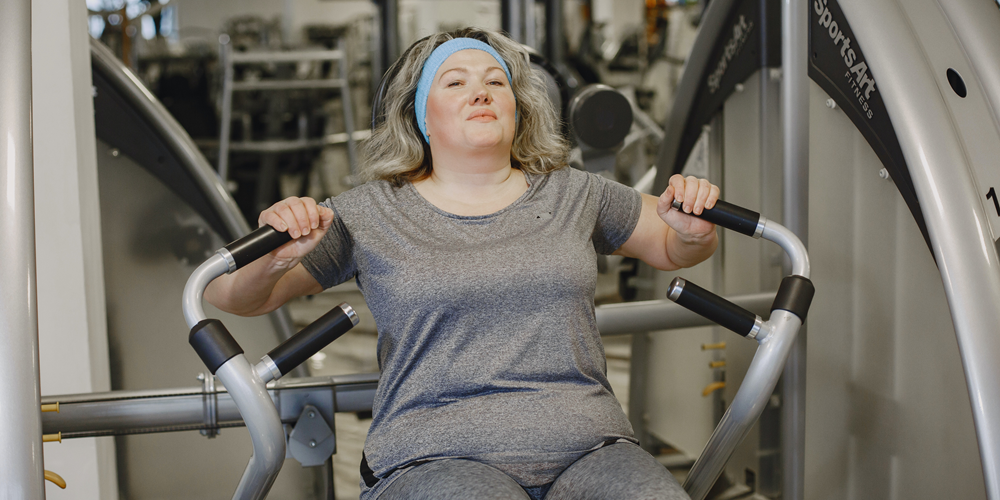Month: February 2025
Maintain Your Muscle

Strength Training at Any Age
You’ve likely heard that exercise can help you live a longer, healthier life. When you hear the word ‘exercise,’ you might think of going for a run or hopping on a bicycle. Or maybe playing soccer with your kids or basketball with your friends after work. But these activities don’t include all the types of movements that are important for your health.
The examples above are endurance exercise. Also called cardiovascular exercise, activities like these increase your breathing and heart rate. They can keep your heart and lungs in good shape and help prevent many chronic diseases. But exercises to maintain flexibility, balance, and strength are also important.
Stretching gives you more freedom of movement and makes daily activities more comfortable. Balance practice helps prevent falls, which become a concern as you get older.
Strength training, also called resistance training or weight training, is particularly important. It brings many benefits. First, it makes your muscles stronger. That can help you keep up the activities you enjoy—at any stage of your life.
It’s not about getting big muscles, explains Dr. Wendy Kohrt, an aging expert at the University of Colorado. In fact, most people who do strength training don’t see much of a change in muscle size.
But at all stages of life, she says, “maintaining muscle mass and muscle function is really important for quality of life.”
Start Building Muscle Safely
Scroll through the images below for tips on getting started with resistance training.
Building Up Benefits
Building muscle can do more than make you stronger. Some types of strength training keep your bones healthy, too. Strength training can also improve the way your body processes food to help prevent diabetes and related diseases.
“And like endurance activity, regular strength training is associated with lower risk of cardiovascular disease and other chronic diseases,” says Dr. Joseph Ciccolo, an exercise researcher at Columbia University.
But the main benefit of strength training, as the name suggests, is that it makes your muscle cells stronger. “That benefit is unique to strength training,” says Dr. Roger Fielding, who studies the benefits of exercise at Tufts University.
Experts recommend that children and teens do muscle-strengthening activities at least three days a week. For adults, they encourage strength training for the major muscle groups on two or more days a week.
The benefits of strength training increase as you get older, says Fielding. Maintaining strength is essential for healthy aging.
“Loss of muscle with aging can limit people’s ability to function in their home environment and live independently,” Kohrt says. “Just being able to get up out of a chair or go up and down stairs requires a fair amount of muscle strength.”
In a recent study, Fielding and other researchers tested a three-month weight-lifting program in older adults who already had difficulty walking. At the end of the study, participants who lifted weights improved at tasks like repeatedly bending their knees. Such movements are essential for activities of daily living. In contrast, study participants who only stretched at home did not see similar improvements in strength.
“As we age, I think it’s even more important to consider incorporating some strength training into our physical activity routines,” says Fielding. “We can either slow down the progression of age-related muscle loss or prevent it.”
Getting Started
If you want to get started with strengthening exercises, what should you do? Strength training may seem intimidating if you’ve never tried it.
“People naturally learn to walk as part of growing up. But you don’t necessarily learn how to lift weights,” Ciccolo says.
If it’s feasible for you, booking a few sessions with a personal trainer is a good way to get started, says Kohrt. “That can get you introduced to the types of exercises you could do,” she explains.
There are also many low- or no-cost classes available. Look for them at local gyms, recreation centers, senior centers, and community centers.
Like with any new activity, to make strength training stick, “you have to find something that you really like to do,” says Fielding. “Some people will want to exercise in a group, in a community setting. Others will be happy doing all their exercises in their home, by themselves.”
If you’ve never lifted weights before, talk with your health care provider before you start any home-based strength training routine.
Whatever you choose to do, “start slowly and build up very gradually,” says Kohrt.
Source: NIH News in Health, March 2020
Independence for Older and Disabled Adults

In July we celebrate liberty and justice for all. Sadly, as we age well intentioned fellow Americans often chose to curtail older or disabled Americans’ inalienable rights.
Overprotection may appear on the surface to be kind, but it can be really evil. An oversupply can smother people emotionally, squeeze the life out of their hopes and expectations, and strip them of their dignity.
Robert Perske
Is there such a thing as too much protection? Yes! Older and disabled adults deserve the right to make decisions about their own life that could expose them to potential harm. It is called dignity of risk, and it is an essential human right. The term, dignity of risk, was first coined in 1972 by Robert Perske in reaction to over-protective safeguards and a paternalistic manner by direct care staff toward elders in institutional settings, which he argued, was patronizing and diminished a person’s freedoms and self-esteem.
Today the term dignity of risk refers to the concept of affording a person the right (or dignity) to take reasonable risks, and that the impeding of this right can suffocate personal growth, self-esteem and the overall quality of life (Ibrahim & Davis 2013).
Yet even today well-intentioned relatives and caregivers are stripping away older and disabled Idahoan’s civil and legal rights, self-esteem, and quality of life by pursuing guardianship with the motivation to keep their older loved ones safe. Although we applaud the motivation, the Idaho Commission on Aging advocates for older and disabled adults by urging concerned caregivers to consider the multitude of alternatives to guardianship for as long as possible.
What are alternatives to guardianship? Some examples include:
- Representative payee
- Durable powers of attorney
- Health care surrogacy
- Living wills
- Trusts
- Community advocacy systems
- Joint checking accounts
- Case management

Power of Attorney
A power of attorney is a legal document. The document grants one person, generally called an agent, sometimes known as an attorney in fact, the authority to act on behalf of the person appointing them. The person appointing the agent is called the grantor. To create a power of attorney, an adult must be able to understand they are appointing the agent and understand the kinds of authority they are giving the agent. The scope of the agent’s authority is limited by the terms of the document and by state laws. A grantor with capacity can revoke or modify the appointment of an agent in a power of attorney. Revocation of a power of attorney should be in writing, signed by the grantor, with a copy delivered to the agent and anyone who is likely to be dealing with the agent. In some states, the revocation needs to be recorded in the public records like a deed. A power of attorney is a private agreement and is not subject to automatic oversight by the Courts.
Social Security Representative Payee
A Social Security Representative Payee (rep payee) receives the benefits for a beneficiary who has been determined unable to manage money by the Social Security Administration (SSA). Rep payee is specific to Social Security benefits, including Social Security Disability and Supplemental Security Income (SSI). VA pensions and some private pensions have separate payee systems. Social Security will place the benefits in payee status if SSA has reason to believe that the beneficiary is unable to manage benefits. The evidence is either a verification from a physician who has seen the person recently, or evidence in a disability case of serious mental illness or substance abuse. The beneficiary can file voluntarily if they are unable to manage their benefits. The process is entirely administrative. Social Security does not recognize any other agents. Guardians and agents under powers of attorney must apply to Social Security to be recognized as a representative payee.
Someone seeking to be appointed as a rep payee should contact Social Security with the name and identifying information for the beneficiary, the reason the person needs a payee, and name and contact information of a physician who has recently seen the person and may include a proposed payee. Social Security then sends notice to the beneficiary, and a verification form to the physician. The beneficiary has a right to object to the need for a payee, or to the proposed payee. Upon finding of need for a rep payee, Social Security does a basic background check on the proposed payee. The payments must be directly deposited into a separate account, titled “payee as representative payee” for the benefit of the named beneficiary. Most payees file a very basic annual accounting. Representative Payee status can be terminated, at request of the beneficiary, with proof that the beneficiary has regained the ability to manage benefits. If the payee resigns or becomes unable to serve, benefits are held until a replacement payee can be appointed. There is a shortage of reliable volunteer payees and a need for representative payees. All payees are volunteers, with an exception for narrowly defined non-profits who are allowed to receive a limited fee from the benefits. In some states, inpatient residential settings, such as nursing homes, are allowed by state law or regulation to serve as representative payees.

Health Care Surrogate
A health care surrogate is a person who makes health care decisions for a person, when the person lacks capacity to make health care decisions. This person may also be called a health care agent or proxy. In every state, a person with capacity can appoint a health care surrogate in a durable power of attorney that incudes health care authority. Many states have a short form for naming a health care surrogate. A person has capacity to appoint a health care surrogate if they understand what a health care decision is and can name a person they trust to make health care decisions. If a person does not appoint someone, 45 state statutes give guidance on who can make health care decisions. Generally, statutes turn to the nearest relatives to make health care decisions. Health care decision-making is the only area of decision-making where the law creates a default agent when a person does not name an agent in writing.
The authority of a health care surrogate to make health care decisions does not start until the person loses capacity, or knowingly defers to the agent. The determination of loss of capacity is made by the person’s health care providers. The criteria and documentation for the loss of capacity is based on state law. The scope of the authority is defined in the document and by state law. If the person has capacity, the person can revoke or modify the appointment of a surrogate. Many states have a very low standard of capacity for revocation of an advance directive. Aside from leaving directions on who can make health care decisions, many people leave directions about the health care they want or do not want in the form of an advance directive or living will directive. When making health care decisions for another person, it is helpful to understand their health care values, goals of care, and specific wishes.

Bank Accounts
A common way to manage another person’s finances is to authorize an agent to sign on to that person’s bank accounts. There are two ways to do this: 1) add a person authorized to transact business on the account; or 2) make the bank account a joint account. A joint account creates a presumption of ownership in the account assets and may create inheritance rights. Joint accounts are very helpful for married or committed couples. For more distant family members or friends, joint accounts should be used with great caution. Rather than create a joint account, the bank can authorize someone to sign on the account without creating an ownership interest in the account.
This is commonly accomplished by the bank recognizing the authority granted under a power of attorney. In many states, the banks may insist on a state standard form, or a bank approved power of attorney form. Banks can also authorize signers on accounts without creating an ownership interest; many business accounts are structured this way. Direct deposit and automatic payment for All Social Security benefits and virtually all retirement benefits are paid by direct deposit. Direct deposit eliminates the need to make deposits and prevents lost or stolen checks. Nearly all reoccurring bills can be set up on automatic payment. The combination of direct deposit and automatic payments can help to assure that necessary bills are paid when a person is unable to attend to finances. These arrangements should be monitored to assure that all income is properly received, and automatic payments are correct. Increasingly, financial institutions and utility providers are willing to send copies of invoices and statements to a third party, or to arrange online access for accounts oversight.
This information was supported by a contract with the National Center on Law & Elder Rights, contract number HHSP233201650076A, from the U.S. Administration for Community Living, Department of Health and Human Services, Washington, D.C. 20201
Additional resources to help concerned family and caregivers support their older relatives without the civil death of full guardianship are:
- A Guide to Managing Someone Else’s Money
- Alternatives to Guardianship and Conservatorship for Adults (explains supported decision making)
- What Caregivers Should Know About Managing a Loved One’s Money (a guide from AARP)
Thank you for standing up for life, liberty, and the pursuit of happiness for older Idahoans! Visit the ICOA website for additional information and services to help older Idahoan’s age with safety and dignity.
Resident’s Rights: What to Expect

When a loved one no longer is able to remain at home safely with supports it pays to have some basic knowledge when faced with the task of finding appropriate placement. Long-Term Care is a system unto itself with a language that most do not know if they have not had experience with either Skilled Nursing care or Assisted Livings facilities.
Take the time to explore options available for your loved one and take the time to personally visit facilities in the area that you would like your loved one to reside.
When you visit your facility options observe:
- The feeling of entering into the facility
- Smell or odors
- Volume of music, laughter, staff communications, other sounds
- Staff interactions with residents
- A meal when possible
Are:
- You greeted and welcomed by a staff
- Conversations with administration focused on financial rather than on resident care.
And visit during the weekend to observe staffing and the facility environment
The big Question is– are staff “Resident Centered”?
Types of Long -Term Care-
Skilled nursing care requires a skilled medical need for services to be authorized for insurance coverage. If the resident has Medicare it pays for the first 20 days and then the resident is required to private pay for the room and board for up to the next 100 days if there is no other payment source. For Medicare to cover, the individual must have a 3 day stay in the hospital. Medicare will not cover if the individual was admitted to the hospital for observation rather than treatment.
When an individual does not have a medical need for placement and is in need of long-term care services that is beyond assisted living care, options for payment may be long term care insurance, private pay or Medicaid.
The person Centered Care Plan in skilled Nursing Care or long term care guides the care that an individual has been assessed to need for their best quality of life.
Assisted Living level care is not a skilled level of care. According to Idaho Licensing and Certification “A Residential Assisted Living Facility is a facility or residence operated on either a profit or nonprofit basis for the purpose of providing necessary supervision, personal assistance, meals, and lodging to three or more adults”.
In an Assisted Living facility, the Negotiated Service Agreement guides the level of care required to meet the residents needs and increase or maintain their quality of life.
Residents and resident representative should have a voice in the development of these care plans.
Prior to signing an admission agreement—read the entire agreement and do not sign until you have read and understand what you are agreeing to. At a later time should you have questions or concerns it may be dependent upon what was in the admission agreement as to what rights you may have going forward. Keep a copy of the Admission Agreement that was signed upon admission.
Nationally staffing is at critical levels due to shortages. There has never been a more important time to be aware and involved in the long-term care of a loved one.
Know your rights. Every facility is required to post residents rights. When you have concerns or questions related to resident care contact your local Area Agency on Aging Long-Term Care Ombudsmen they are a great resource for information and resident advocacy.
Know who your advocates are and how to contact them- Ombudsmen are formally trained advocates that can help when family efforts aren’t enough.
Visit the ICOA website for additional information and services to help older Idahoan’s age with safety and dignity. www.aging.idaho.gov
 Official Government Website
Official Government Website





